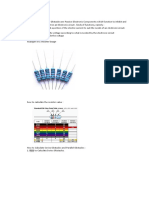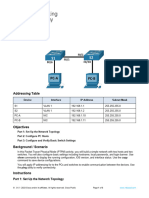Title: Semiconductor. (H005)
Title: Semiconductor. (H005)
Uploaded by
BookMaggotCopyright:
Available Formats
Title: Semiconductor. (H005)
Title: Semiconductor. (H005)
Uploaded by
BookMaggotOriginal Description:
Original Title
Copyright
Available Formats
Share this document
Did you find this document useful?
Is this content inappropriate?
Copyright:
Available Formats
Title: Semiconductor. (H005)
Title: Semiconductor. (H005)
Uploaded by
BookMaggotCopyright:
Available Formats
Title : Semiconductor.
(H005)
Objective: 1. Able to explain the principles of semiconductor operation. 2. Know the types of semiconductor materials and the operations of electrons and holes.
Result: Dual lamp control. 1. When switch A is up, lamp 3 is on. 2. When switch A is down, lamp 4 is on.
Conclusion: Semiconductor is one device that can conduct current at same time and can be insulators at other times. The semiconductor can act like a variable resistors or a switch by varying the applied voltage.
Title: The Diode.
(H010)
Objectives: 1. Able to explain the operation of semiconductor. 2. Able to describe the operation and forward and reverse bias in a diode. 3. Know the schematic symbol for a diode.
Results: Forward Bias Voltage The output voltages across the forward biased diode is closes to 0.6 Volt Diode Actions 1. When switch A up, lamp is on. 2. When switch A down, lamp is off. AC Voltages 1. AC voltages with diode dimmer are 3 VAC. 2. AC voltages without diode dimmer are 7 VAC.
Conclusion: When switch A is up, it is forward biased. Forward bias connected to AC circuit and allows current to flow only half the time. When switch A is down, it is reverse biased. Reverse bias connected to DC circuit and DC does not flow easily through it.
Title: Diode Rectifiers. ( H011)
Objectives: 1. Learn to identify half-wave and full-wave diode rectifier circuits. 2. Calculate the Average DC Voltage from the AC Peak Voltage.
Result: Waveform Voltages 1. Peak Voltages = 14.5 V
2. Average Voltages = 0.637 x 14.5 = 9.23 V 3. Measured Average Voltages = 8.7 V 4. RMS Voltage = 0.707 x 14.5 = 8.7 V 5. Measured RMS Voltages = 9 V Power Supplies Measured Filter Voltage = 13 Volts DC
Conclusion: In a half-wave rectifier the peak voltage is about half the average value. The output waveform for the full-wave rectifier is identical to that of the half-wave rectifier. In a full-wave rectifier the peak voltage is equal to the average voltage.
Title: LEDs and Opto-Diodes. ( H050)
Objectives: 1. Able to explain the idea of optoelectronics. 2. Able to test the operation of light emitting diodes. 3. Able to describe the operation of light detecting diodes. 4. Able to test optoelectronic integrated circuits.
Results: Currents, Voltage and Power. 1. Switch A up, Lamp Voltage = 8.2 V Lamp Current = 3.9 Milliamperes
2. Switch A down, LED Voltages = 0 V LED Current = 38.9 Milliamperes
Conclusion:
When a light emitting diode is reversed biased, it is off, while if the light emitting diode is forward biased, it is on.
Title: Zener Diode. (H060)
Objectives: 1. Learn to describe the circuit and operation of a Zener Diode Regulator. 2. Learn to describe and calculate the Zener power supply regulation
Result: Zener Voltage 1. No Load Voltage = 4 V 2. Under Load = 3.8 V Zener Regulation
Regulation = 4 3.8 x 100% 4
=5
Conclusion:
If the zener diode were reversed, the lamp would turn off, but the lamp would turn on if the zener diode were forward biased.
You might also like
- Lesson PlanDocument6 pagesLesson Plantrhizza92% (38)
- Full Wave Rectifier Single Phase ReportDocument10 pagesFull Wave Rectifier Single Phase ReportAmer Al-khorasaniNo ratings yet
- Lab Report 1. Diode Characteristics HalfDocument10 pagesLab Report 1. Diode Characteristics HalfayasumireNo ratings yet
- Aircraft PneumaticDocument3 pagesAircraft PneumaticBookMaggotNo ratings yet
- Diff Pairs - Behzad Razavi Lecture NotesDocument14 pagesDiff Pairs - Behzad Razavi Lecture Noteshsharghi75% (4)
- Year 9 Physics - Electricity PPDocument37 pagesYear 9 Physics - Electricity PPbennnyheley440No ratings yet
- Basic ElectronicsDocument18 pagesBasic ElectronicsZin Maung TunNo ratings yet
- Electronics (Basics Diodes)Document130 pagesElectronics (Basics Diodes)ramanaidu1No ratings yet
- Bee 18esee02l Lab ManualDocument43 pagesBee 18esee02l Lab ManualGemechu TayeNo ratings yet
- Construction & Operation of Some Simple Electrical Circuits: Name of The ExperimentDocument7 pagesConstruction & Operation of Some Simple Electrical Circuits: Name of The ExperimentSayeed MohammedNo ratings yet
- Basic Electrical Engineering Laboratory Exp 3Document5 pagesBasic Electrical Engineering Laboratory Exp 3Afiq BahaNo ratings yet
- G14 Voltammetry ReportDocument81 pagesG14 Voltammetry Report7128beaNo ratings yet
- ElectricityDocument283 pagesElectricityOmar M AlsalmanNo ratings yet
- UNIT 2.docxDocument11 pagesUNIT 2.docxabhimanyukr00003No ratings yet
- 1.2.3 Electic CircuitDocument8 pages1.2.3 Electic CircuitNavya ChirutaNo ratings yet
- Lab Report 2Document17 pagesLab Report 2EvaNo ratings yet
- Worksheet: Electric Current, Battery and Bulb: Activity 1-1Document29 pagesWorksheet: Electric Current, Battery and Bulb: Activity 1-1Neil CorpuzNo ratings yet
- Basic Electronics ReportDocument25 pagesBasic Electronics ReportMahnam Nasir Nasir NaeemNo ratings yet
- Semiconductor IntroDocument69 pagesSemiconductor IntroPePe ParkerNo ratings yet
- Half Wave RectDocument5 pagesHalf Wave RectVinay JainNo ratings yet
- System Practice 1Document6 pagesSystem Practice 1Angel CiméNo ratings yet
- Answer 4Document4 pagesAnswer 4Shubham imtsNo ratings yet
- EE 306 - Electrical Engineering LaboratoryDocument7 pagesEE 306 - Electrical Engineering LaboratoryMohammed KhouliNo ratings yet
- DEVICE EXP 2 Student - 2Document4 pagesDEVICE EXP 2 Student - 2Pablo ChanNo ratings yet
- Diodes: Experiment GuideDocument7 pagesDiodes: Experiment GuideDeke Elektronik IndustriNo ratings yet
- HiDocument33 pagesHifarzanakhan42ka1No ratings yet
- Complete Electronics Self-Teaching Guide with ProjectsFrom EverandComplete Electronics Self-Teaching Guide with ProjectsRating: 3 out of 5 stars3/5 (2)
- Basic Electronics Report: Submitted by Group Members Submitted To Date of Submission Grade/ PointsDocument23 pagesBasic Electronics Report: Submitted by Group Members Submitted To Date of Submission Grade/ PointsMahnam Nasir Nasir NaeemNo ratings yet
- Laboratory Experiment No. 1: Freewheeling of The Inductive EnergyDocument5 pagesLaboratory Experiment No. 1: Freewheeling of The Inductive EnergyZander Rein FernandezNo ratings yet
- Exp 02Document18 pagesExp 02eversin082No ratings yet
- Final Project in Nee - 2102-MananganDocument11 pagesFinal Project in Nee - 2102-MananganJaypee PascualNo ratings yet
- Practice#1-U2 RamayoDocument13 pagesPractice#1-U2 Ramayocesar ramayoNo ratings yet
- Fundamentals of Electronics For StudentsDocument3 pagesFundamentals of Electronics For StudentsCequan HolderNo ratings yet
- ETN1B PracDocument12 pagesETN1B Pracnkosingiphilephiri639No ratings yet
- Unit I Basic Circuits AnalysisDocument36 pagesUnit I Basic Circuits AnalysisHarvey PingcasNo ratings yet
- Lesson Plan Electricity CircuitsDocument6 pagesLesson Plan Electricity CircuitsEnelra Nat VilNo ratings yet
- EXP. 1-Filtered Power SupplyDocument4 pagesEXP. 1-Filtered Power SupplyJustine LentijasNo ratings yet
- Emergency LightDocument12 pagesEmergency LightEysha qureshiNo ratings yet
- RWEP Final9 14 Assessment Questions v5Document7 pagesRWEP Final9 14 Assessment Questions v5K RamakrishnanNo ratings yet
- Adaptive Lighting System For AutomobilesDocument30 pagesAdaptive Lighting System For AutomobilesDeepthi Dsouza100% (1)
- A. ResistorDocument5 pagesA. ResistorErwin AhmadNo ratings yet
- Discussion For The Most Part, in Performing This Experiment, We Only Used Diodes of Different Kinds, Multimeters, and A Power SupplyDocument2 pagesDiscussion For The Most Part, in Performing This Experiment, We Only Used Diodes of Different Kinds, Multimeters, and A Power SupplyEj HidalgoNo ratings yet
- Nas U1Document79 pagesNas U1Ashmit RajNo ratings yet
- English For Technical EngineerDocument27 pagesEnglish For Technical Engineer22138023No ratings yet
- EET219 2023 Lecture 2Document54 pagesEET219 2023 Lecture 2j9927091No ratings yet
- ENEL585 Lab1Document4 pagesENEL585 Lab1phanioletyNo ratings yet
- Experiment 1 Docx - Comp EngDocument26 pagesExperiment 1 Docx - Comp Engapi-344058913No ratings yet
- BASIC CIRCUITS ANALYSIS Unit 1 NotesDocument31 pagesBASIC CIRCUITS ANALYSIS Unit 1 NotesLOOSUPANNINo ratings yet
- Diode: What Is A Diode?Document10 pagesDiode: What Is A Diode?Sarah Grace Cabilte100% (1)
- EEE1302 - Lab No 03Document6 pagesEEE1302 - Lab No 03tithynusrat812No ratings yet
- Principles of Electrical Engineering Lab 2020-21Document68 pagesPrinciples of Electrical Engineering Lab 2020-21riko.mori.toi22No ratings yet
- Your Fall 2016 Motor Madness Winners: - Aaron Florian, Braden Mishler, Cole Nyffeler, Jesus Quintanilla-Cruz. - Who WinDocument17 pagesYour Fall 2016 Motor Madness Winners: - Aaron Florian, Braden Mishler, Cole Nyffeler, Jesus Quintanilla-Cruz. - Who WinNathan KingNo ratings yet
- Lab 8Document13 pagesLab 8Richard LangNo ratings yet
- Chap 6Document8 pagesChap 6S M JOYNo ratings yet
- Chap 6Document8 pagesChap 6S M JOYNo ratings yet
- Chapter 1 Summary (Introduction To Semiconductors) : Crystal Conduction ElectronsDocument14 pagesChapter 1 Summary (Introduction To Semiconductors) : Crystal Conduction ElectronsGregorio Miguel Borja AguilaNo ratings yet
- PW5 ElectronicsDocument29 pagesPW5 ElectronicsMichael KavanaghNo ratings yet
- Electronic Circuits and Devices Laboratory - ELCE-221 Experiment No. 2 Diode Applications (Part A) Rectifiers, ClippersDocument6 pagesElectronic Circuits and Devices Laboratory - ELCE-221 Experiment No. 2 Diode Applications (Part A) Rectifiers, ClippersLittle VoiceNo ratings yet
- STEM: Science, Technology, Engineering and Maths Principles Teachers Pack V10From EverandSTEM: Science, Technology, Engineering and Maths Principles Teachers Pack V10No ratings yet
- Vector Mechanics For Engineers-STATICSDocument15 pagesVector Mechanics For Engineers-STATICSBookMaggot50% (2)
- Why Choose MBA MSC BUSDocument1 pageWhy Choose MBA MSC BUSBookMaggotNo ratings yet
- Understanding The Concept of The Gear Ratio: 1.27 Inches / 2 0.635 InchesDocument1 pageUnderstanding The Concept of The Gear Ratio: 1.27 Inches / 2 0.635 InchesBookMaggotNo ratings yet
- QuestionaireDocument7 pagesQuestionaireBookMaggotNo ratings yet
- Seat Pitch Position On Two Seats, One Behind The Other - It Is NOT The Legrest Area As SomeDocument3 pagesSeat Pitch Position On Two Seats, One Behind The Other - It Is NOT The Legrest Area As SomeBookMaggotNo ratings yet
- Toefl 3Document8 pagesToefl 3sangho,wooNo ratings yet
- Typical Aircraft Charging CircuitDocument1 pageTypical Aircraft Charging CircuitBookMaggotNo ratings yet
- Report Landing Gear Sek AkuDocument3 pagesReport Landing Gear Sek AkuBookMaggotNo ratings yet
- Ata Presentation Power PointDocument9 pagesAta Presentation Power PointBookMaggotNo ratings yet
- Lesson C - 4 Ch03 Auditing PC-Based Accounting SystemsDocument22 pagesLesson C - 4 Ch03 Auditing PC-Based Accounting SystemsMaria Caesarina Claire Berdin0% (1)
- Smartmesh Rev DDocument12 pagesSmartmesh Rev DNIKHIL ASNo ratings yet
- Diploma in Electronics Engineering: Effective From Academic Year 2021-22Document58 pagesDiploma in Electronics Engineering: Effective From Academic Year 2021-22Sapna KumariNo ratings yet
- Practical File Cs 083 BVM 2023-2024Document40 pagesPractical File Cs 083 BVM 2023-2024Syed Jazil.No ratings yet
- WLC TshootDocument32 pagesWLC TshootSubhashNo ratings yet
- Memory and Its Types: Primary and Secondary Memory M Husnain BS Chemistry 4th Bsf1907949Document7 pagesMemory and Its Types: Primary and Secondary Memory M Husnain BS Chemistry 4th Bsf1907949M Hasse KhanNo ratings yet
- Eoc 1 Sesi 1 2021-2022Document3 pagesEoc 1 Sesi 1 2021-2022Muhammad Naim bin IshakNo ratings yet
- Implementing Global Human Resources PDFDocument860 pagesImplementing Global Human Resources PDFRamya PoppyNo ratings yet
- 2.9.2 Packet Tracer - Basic Switch and End Device Configuration - Physical ModeDocument3 pages2.9.2 Packet Tracer - Basic Switch and End Device Configuration - Physical ModeNick WonderNo ratings yet
- CL 9000 Data SheetDocument9 pagesCL 9000 Data SheetDiego GranadosNo ratings yet
- Object Oriented Programming - SCJ2153: Associate Prof. Dr. Norazah YusofDocument15 pagesObject Oriented Programming - SCJ2153: Associate Prof. Dr. Norazah YusofMohannan RajamahendranNo ratings yet
- Adding An Allen Bradley PLC To NI OPC Servers - National InstrumentsDocument7 pagesAdding An Allen Bradley PLC To NI OPC Servers - National Instrumentsmarioni_a1No ratings yet
- Z CAM E2 Flagship Series User Manual Draft v0.2 FW0.93Document47 pagesZ CAM E2 Flagship Series User Manual Draft v0.2 FW0.93astridNo ratings yet
- CS 228: Database Management SystemDocument46 pagesCS 228: Database Management SystemSaimo MghaseNo ratings yet
- Product Brochure Lionbrix Material HandlingDocument2 pagesProduct Brochure Lionbrix Material HandlingChrister AlfredssonNo ratings yet
- NSE Question Bank AnswersDocument14 pagesNSE Question Bank AnswerslinhNo ratings yet
- Claims Management SystemDocument8 pagesClaims Management SystemVPLAN INFOTECHNo ratings yet
- DSSK 30-018A Diode Kep PDFDocument2 pagesDSSK 30-018A Diode Kep PDFHưng HQNo ratings yet
- Atlas AiDocument69 pagesAtlas Aiextra junkNo ratings yet
- YamMonManual 1.0Document5 pagesYamMonManual 1.0Pierpaolo LatìnaNo ratings yet
- Service ManualDocument18 pagesService ManualBuitinės Technikos RemontasNo ratings yet
- IT15 Decorators Python Draft23Document5 pagesIT15 Decorators Python Draft23amol nagraleNo ratings yet
- Krupal Ldhund-PagesDocument1 pageKrupal Ldhund-PagesKrupal ksNo ratings yet
- SoftstarterCatalog 1SFC132012C0201revI Lowres 1Document15 pagesSoftstarterCatalog 1SFC132012C0201revI Lowres 1Andri PristaNo ratings yet
- 5G NR Course OutlineDocument4 pages5G NR Course OutlineAqeel HasanNo ratings yet
- Matlab Web App Server Quick Start GuideDocument3 pagesMatlab Web App Server Quick Start GuideJuphil PletoNo ratings yet
- VLSI Interconnects: Credits: David HarrisDocument46 pagesVLSI Interconnects: Credits: David Harrisparty0703No ratings yet
- DSP NotesDocument15 pagesDSP Notesradz248No ratings yet
- Cs Blind StickDocument60 pagesCs Blind Stickhamed razaNo ratings yet



































































































